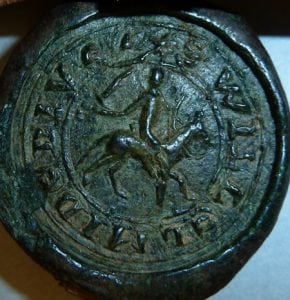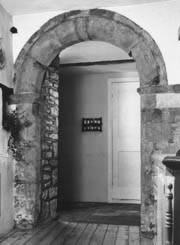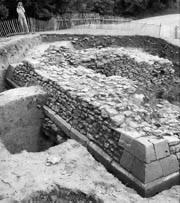Millennium Project
Rob Forsyth
 In this image (click to zoom) the original mound (motte) on which the castle stood can be seen in the back ground centre left. The earth works which surround what was the old bailey - now called the Grounds - can be seen amongst the trees to the right and to the left. These extend all the way round. A favourite dog walk is in the old moat beyond. Children particularly like the moat and build huts out of stray branches in which to hide and attack the castle.
In this image (click to zoom) the original mound (motte) on which the castle stood can be seen in the back ground centre left. The earth works which surround what was the old bailey - now called the Grounds - can be seen amongst the trees to the right and to the left. These extend all the way round. A favourite dog walk is in the old moat beyond. Children particularly like the moat and build huts out of stray branches in which to hide and attack the castle.
A brief history
The site lies to the east of the town and comprises some 8 acres. The castle was built by or for Bishop Odo of Bayeux, half brother of William the Conqueror, as the headquarters of his extensive estates in Oxfordshire, and appears to have been a place of considerable strength in the twelfth century. William de Chesney, Lord of Deddington, held the castle in the mid twelfth century when England was ravaged by civil war, but during the struggle between King Richard and his brother Prince John in the late twelfth century it was seized by the Crown. Descendants of the Chesneys, the Dive family, regained possession in the thirteenth century* and styled themselves 'Lord of Deddington Castle', but by the end of that century it was partially demolished and by 1310 there seems to have been little left apart from "a chamber and a dovecote". By 1377 stonework from the walls was being sold off. To the south east of the site is a field known as 'The Fishers' which was presumably originally the fishpond for the castle.

*Editor's note November 2025: In the 1360s St George's Chapel, Windsor, subsequently acquired 1/3 of the Castle from the Dive family and it remained in the Chapel's ownership until 1867 when it was forfeited to the Ecclesiastical Commissioners. To read more about St George's ownership of Castle and land in Deddington click on the image (l) of a deed seal
In 2022 the Castle Grounds
are a grassed-in enclosure surrounded by banks and trees on three sides
and is used as a recreational area for walking dogs and other leisure
activities.
Archaelogical digs
There have been a number of archaeological "digs" between 1947 & 53 and again between 1977 & 79. These have uncovered evidence of some Saxon building on the site, but the main evidence, both archaeological and documentary, is of the castle in the eleventh to fourteenth centuries. There was an inner bailey containing a stone hall, a solar and chapel, with a tower on the east side and a gatehouse on the west side giving access to the large outer bailey. Pottery from the 11th to 13th centuries was found on the site. A full report on the 1977-79 digs (with reference to earlier ones) by Prof.J.Ivens on behalf of Queens University Belfast can be read HERE. (pdf) and one by the Council for British Archaeology HERE (pdf)
| click on images to enlarge |
Chris Day (historian) writing for Cake & Cockhorse Journal
Chris was a professional historian who lived in Deddington and was Chairman of the Deddington & District History Society for many years. His deeply researched and extensive article from the 2022 edition of the Cake & Cock Horse can be read HERE (pdf) with grateful thanks to the editor, Helen Forde, and committee of the Banbury Historical Society. A tribute to Chris containing details of his long historical research career can be read HERE
Richard Ivens (archaeologist) writing for Oxoniensia 49
Richard's article from the 1984 edition can be read HERE (pdf) with grateful thanks to the Editor and Committee of the Oxford Architectural and Historical Society. Richard was a student of Martyn Jope, a well known archaeologist (as his Royal Academy biography recounts) who had carried out two earlier diggings betyween 1945 and 1950. However, all these excavations were not fully published. Richard, when he finalised the 1977-1979 excavation, incorporated Jopes’ notes on the latter's second excavations and had a draft ready but he found further material from the the earlier Jope excavations when he was clearing Jope’s house in Oxford after his wife, Margaret, died in 2004. Following his untimely death from Covid-19 in May 2020, Richard’s partner, Dr Isobel Lisboa, intends to collate, record and send all the artefacts and records to the Ashmolean Museum.
More information
The Deddington News carried an article in September 1977 by Andrew Macgregor
The Banbury Guardian had a photo and article in 1977
The Oxford Mail carried an article on 7 May 2013 by Trevor Rowley
St George's Archives, Windsor, chose the Seal of Sir William de Dive in November 2025, on a Deed relating to the castle in the 1360s, as their image of the month.
Was there a castle there when Odo was granted the land?
There was a mound and timber castle but when Odo took over the Castle he
strengthened its defences, building a stone castle on the site some
time after 1086. This was reinforced in the 1100s but became less
useful in the 1200s, and by the end of the 14th century the castle had
largely gone, the stones being sold, “borrowed”, or carted away. The
inner bailey was excavated in the 1940s and 1970s, revealing fine ashlar
stone foundations which still lie under today’s grass mound. A Saxon
penny was found near it; 12th century glass from it is in the Ashmolean
Museum; excavations revealed the oldest black rat skeleton in the
country.
National Heritage describeds the site as:
'A large undifferentiated enclosure with a substantial motte at its east
end. This is a very unusual form and unique in the Oxfordshire area….
Its great size and early date may suggest that it was of more than
ordinary importance, in fact a baronial castle’ (R.J.Ivens).
Deddington Castle is a scheduled ancient monument, the inner bailey site
in the guardianship of the Department of the Environment and the outer
bailey of Deddington Parish Council. English Heritage: ‘The earthworks
…lie in a rural location to the south east of the village of
Deddington. No stonework is visible above ground today, but the site is
nevertheless a striking one owing to the scale of the earthworks – the
rampart is 15m (49 ft) high in places – and the size of the enclosed
area.’
The Castle Grounds
More information on the Castle Grounds, its use and flora & fauna is continued HERE

